

Curtiss WWII SB2C Helldiver
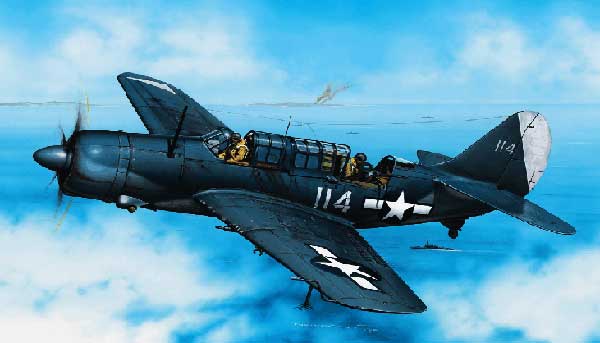
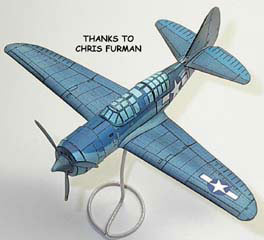
A Carrier-borne dive bomber that joined the Douglas Dauntless during the height of the war in the Pacific. This model comes in two sheets because of it's size in real-life-almost 60 foot wing span. On the second page has a little scale model torpedo.
The long series of Curtiss combat aeroplanes built for the US Navy and Marine Corps between the two world wars was brought to a highly successful conclusion with the company's first monoplane bomber and the last to carry the name Helldiver. Ordered on May 15, 1939, while the earlier Helldiver biplane was still in quantity production.
What people say...
I just finished the helldiver model and it looks really nice!!!!!!!!! It doesn't fly that great but it looks good, specially with the torpedo attached to the underbelly. speaking of torpedo, based one my knowledge on the helldiver it has internal bomb bays like the tbf avenger. im a ww2 plane freak :). im starting a collection of ww2 navy fg planes 'cause i looked at them and they all looked like beauties. whoever designed the fg airplane models should be proud of themselves. they both look good and fly 90% of the time, and that's just how i like it ;). Ray G (04/28/03)
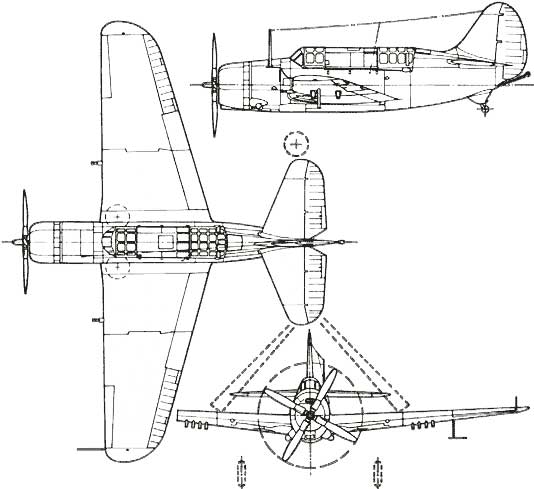
Curtiss SB2C Helldiver
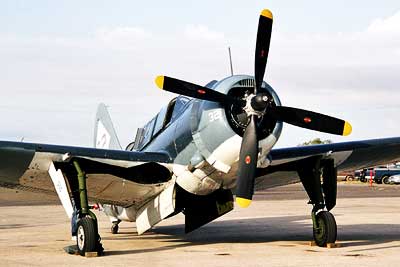
The prototype XSB2C-1, with a 1,700 hp R-2600-8, made its first flight on December 18, 1940, but was destroyed a few days later. Large scale production had already been ordered on November 29, 1940, but a large number of modifications were specified for the production model. The size of the fin and rudder was enlarged, fuel capacity was increased and self-sealing added, and the fixed armament was doubled to four 0.50-in guns in the wings, compared with the prototype's two cowling guns. Curtiss established a new factory for SB2C production at Columbus, Ohio, and the first production model did not fly until June 1942. After the first 200 SB2C-ls, fixed armament was again changed to two 20-mm cannon, in the SB2C-lC version; in addition the Helldiver had two 0.30-in guns in the rear cockpit, and an internal bomb load of 1,000 lb. Production at the new Columbus factory was protracted, and, although deliveries to VS-9 began in December 1942, 11 more months elapsed before the type had been brought up to operational effectiveness and was ready for action.
The first operational sortie was made on November 11, 1943, when VB-17 attacked Rabaul. Production of the SB2C-l totaled 978; one of these was converted to the single XSB2C-2 floatplane, another became the XSB2C-5 and two became XSB2C-6s. The SB2C-3, which began to appear in 1944, had the R-2600-20 engine with a four-blade propeller, while the SB2C-4 had wing fittings for eight 5-in rockets or up to 1,000 lb of bombs and, in the SB2C-4E version, carried a small radar set. Production by Curtiss totaled 1,112 SB2C-3s and 2,045 SB2C-4s.
Finally came 970 SB2C-5s, starting in February 1945, with increased fuel capacity. Two XSB2C-6 prototypes had R-2800-28 engines and longer fuselages. Added capacity for Helldiver production was provided at two Canadian factories; Fairchild produced a total of 300, while Canadian Car and Foundry built 894, these models being respectively equivalent to their Curtiss-built counterparts. Throughout 1944 the Navy's new Helldiver's mounted an ever-growing offensive against Japanese targets in the Pacific, taking over from Douglas SBD's. So vital did they prove in this task that all production of the type was retained by the US Navy with the exception of 26 Canadian-built aircraft supplied to Britain under lend-lease arrangements and designated SBW-IB for this purpose. The Marine Corps took on strength a large portion of the 900 Helldiver's built by Curtiss for the USAAF as A-25As, and these were designated SB2C-IA after transfer.Late versions of the Helldiver remained in US Navy service several years after the end of World War II, and others were supplied to foreign countries.
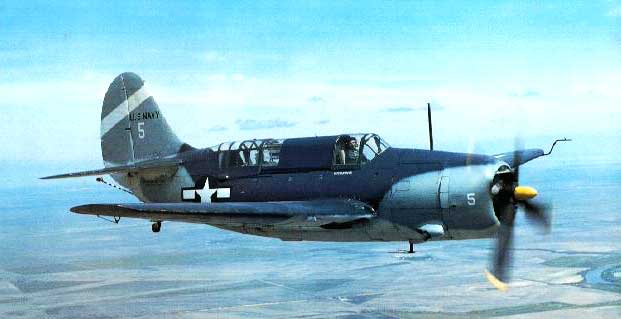
SB2C Helldiver (another write-up)
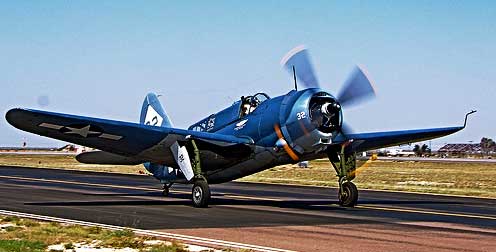
Helldiver's were built in great variety. The 200 SB2C-1 S ("SB" for Scout Bomber) were armed with four .50-caliber machine guns in the wings, two power-driven .50s in the rear cockpit, a 1,000-pound bomb in an internal bomb bay and an additional 1,000 pounds of bombs under the wings. Wing area was 422 square feet and gross weight was 16,607 pounds. Top speed was 273mph at 13,000 feet, but diving speed was limited by perforated and split trailing-edge flaps that served as dive brakes.
An oddity of the SB2Cs with 1942 to 43-style camouflage was that the undersides of the outer wing panels carried dark topside camouflage because the undersurfaces were visible from above when the wings were folded.
The U.S. Army ordered 900 SB2C-1 s under the designation of A-25A. These were built in Curtiss' existing St. Louis plant instead of the Columbus, OH, plant that had been built for SB2C production. Ten A-25As were sent to the Royal Australian Air Force, but they were rejected.
The 410 SB2C-1As were A-25As that were transferred to the U.S. Marines for use as trainers. The 778 SB2C-1Cs ("C' for Cannon) were successors to the SB2C-1, with two 20mm cannon substituting for the four .50-caliber machine guns in the wings. This was the standard armament for subsequent Helldiver's. The single XSB2C-2 was a twin float seaplane that wasn't successful.
The 1,112 SB2C-3s were improved structurally and aerodynamically and used four-blade propellers on 1,900hp R-2600-20 engine. These were followed by SB2C-4s, which had wine racks added for eight 5-in. rockets. Some SB2C-4s were fitted with a radar pod on right-wing bomb rack for operations and were designated SB2C-4E ("E" for Electronics).
The final Curtiss Helldiver model bore a four-blade propeller, the 100-gallon drop tanks on wing bomb racks, the mounts for 5-inch rockets and the overall midnight-blue finish adopted for carrier-based airplanes early in 1944.
Other manufacturers called on to increase production. The branch of Fairchild SB2C-1s as SBF-1 and 150 SB2C-3s as SBF-3. These were followed by 100 SB2C-4Es as SBF-4E.
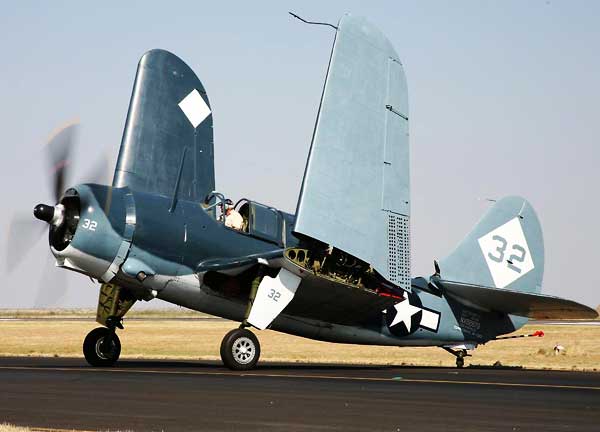
HELLDIVER, as an aircraft appellation, had very strong Hollywood connotations for those of us in the Fleet Air Arm in World War II, conjuring visions of a tensely dramatic Wallace Beery against a colorful pre-war US Navy backdrop, replete with Curtiss dive-bombing aeroplanes, all bracing wires, struts and eye-dazzling insignia. It had become effectively a generic name for all Curtiss naval aircraft assigned to the dive-bombing role since applied at the beginning of the 'thirties to the F8C-4, the first US Navy aeroplane designed from the outset to include dive-bombing in its repertoire. Thanks to the efforts of the Californian film capital, it had also become an emotive, adrenalin-stirring epithet, though not a part of official US Navy nomenclature until the advent of the first monoplane in the series and, in the event, the last of the genus.
Oddly enough, the application of the name "Helldiver" to this last dive bomber was, from one aspect at least, the most opposite. To the American ornithologist, helldiver is the popular name for the diving birds of the family Podicipedidae, known in Europe as grebes and characterized by their short bodies. It was the sharing of this physical trait with its namesake that was to contribute most to the exceedingly poor handling characteristics inherent in the misbegotten Curtiss brute that was to be the last Helldiver. On the other hand, it might be said that the appellation was singularly inappropriate as another characteristic of the helldiver is its mere gesture of a tail, whereas the Curtiss aeroplane ended up with what was, proportionately, just about the largest tail in the business!
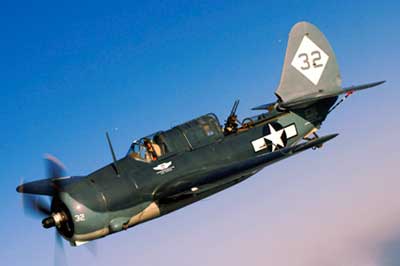 It was later to be said of the Curtiss Helldiver monoplane
that it was a beast at birth and gathered beastliness along with
maturity. At Farnborough, we had little knowledge of the unenviable
reputation that had already earned for it the derisory nickname
of the "Beast " when, late in October 1944, the Helldiver
made its debut at the RAE. We were certainly unaware that this
aeroplane had come within an ace of causing one of the biggest
fiascos in naval aviation history; that in the previous year,
when US Navy squadron VS-9 had taken Helldiver's aboard the newly-commissioned
Essexclass carrier USS Yorktown for pre-operational deployment
trials, the carrier's commander, Capt J J Clark, after witnessing
an horrific series of structural failures, arrester wire misses
and collapsing tail wheels, had urged the US Navy to cut its losses
and abandon the Helldiver production program.
It was later to be said of the Curtiss Helldiver monoplane
that it was a beast at birth and gathered beastliness along with
maturity. At Farnborough, we had little knowledge of the unenviable
reputation that had already earned for it the derisory nickname
of the "Beast " when, late in October 1944, the Helldiver
made its debut at the RAE. We were certainly unaware that this
aeroplane had come within an ace of causing one of the biggest
fiascos in naval aviation history; that in the previous year,
when US Navy squadron VS-9 had taken Helldiver's aboard the newly-commissioned
Essexclass carrier USS Yorktown for pre-operational deployment
trials, the carrier's commander, Capt J J Clark, after witnessing
an horrific series of structural failures, arrester wire misses
and collapsing tail wheels, had urged the US Navy to cut its losses
and abandon the Helldiver production program.
Nor did we know that, four months prior to the Helldiver's appearance at Farnborough, when Task Force 58 had launched a strike against the retreating Japanese Fleet, on 20 June, following the Battle of the Philippine Sea, 90 per cent of the 50 Helldivers participating had been lost - by far the worst attrition suffered by any US shipboard aircraft since the Battle of Midway. We did know however, that FAA squadron No 1820 had formed on Helldiver's at Squantum on 1 April that its aircraft had been shipped back to the UK aboard HMS Arbiter and that the squadron was already awaiting disbandment. We were not tardy in discovering the reason: the handling characteristics of the "Beast" were such that it would never have been allowed near a British carrier deck!
The Helldiver had been conceived to surpass by handsome margins the capabilities of the Douglas SBD Dauntless in every respect, yet ironically, when it was finally - and very belatedly - to achieve operational status, it was to offer only marginal performance advantages over its predecessor, coupling these with some very serious disadvantages. Indeed, some 30 years later, Lt Cmdr James E Vose, who commanded VB- 17 when that squadron was responsible for nursing the Helldiver through its carrier qualification trials and for the operational debut of the dive bomber from the USS Bunker Hill, was to say of the Helldiver, "The SB2C offered little improvement on the SBD. . . the SBD would be my choice!"
The Curtiss SB2C Helldiver had been conceived in 1938, a US Navy specification intended to bring about a quantum advance in the state of the art of the carrier-based dive bomber being translated into hardware by a team led by Raymond C Blaylock. The estimated performance of the proposed aircraft had been impressive and would certainly have produced the immense capability enhancement sought by the US Navy in its dive-bombing force had paper promise been fulfilled by the aeroplane that materialized. Perhaps, as was later to be suggested in mitigation of what was to follow, the US Navy had been too rigid in its specification, allowing the design team insufficient flexibility; perhaps the pressures imposed by the need to maintain the movement of production lines once the aircraft had been committed only permitted palliatives for the dive bomber's more serious shortcomings, disallowing the thoroughgoing redesign that was manifestly necessary. Whatever the cause, the gestation and infancy of the aircraft were to be more noteworthy for their failures than for their successes; the faults that were inherent in the design were never to be eradicated with maturity.
A single prototype of the new dive bomber had been ordered by the US Navy as the XSB2C-1 on 15 May 1939, Raymond Blaylock and his team having conceived a somewhat corpulent but aerodynamically clean low-wing cantilever monoplane representing the very latest thinking in dive bomber design. On the surface, the proposed aeroplane appeared to accomplish successfully the exacting task of mating the large Wright R-2600 Cyclone 14 engine, stipulated by the Bureau of Aeronautics, and the very substantial internal fuel capacity that its use implied, plus an integral weapons bay and a new standard of internal equipment, with the compactness dictated by the arbitrary demands of carrier lift sizes, hangar space. etc. The future Helldiver was both a compact and a dense aeroplane and the seeds of its subsequent problems had been sown.
In so far as Curtiss-Wright was concerned factory floor space
and design office space were at a premium owing to large export
contracts for the Hawk 75A and the newly placed Army Air Corps
contract for the P-40. Work had begun on a new manufacturing facility
at Columbus and this had been earmarked for production of the
new dive bomber, but meanwhile, detail design of the XSB2C-1 had
to be pursued in a nearby cattle barn on the Ohio State University
Fairgrounds. The program had first begun to run into trouble
in February 1940, when wind tunnel testing of models revealed
potentially excessive stalling speeds, necessitating major wing
redesig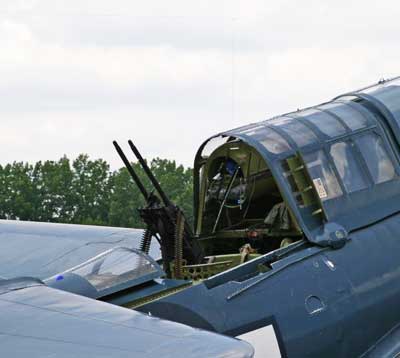 n, gross area being increased by 10 percent, but by the
autumn, the major components of the prototype, which had been
born in the barn, were being transported to the Curtiss-Wright
factory at Buffalo, New York, for final assembly, and from here
the aircraft was to fly for the first time on 18 December 1940.
n, gross area being increased by 10 percent, but by the
autumn, the major components of the prototype, which had been
born in the barn, were being transported to the Curtiss-Wright
factory at Buffalo, New York, for final assembly, and from here
the aircraft was to fly for the first time on 18 December 1940.
From the outset, it could be seen that the XSB2C-1 was facing serious problems, yet, three weeks before the initial flight a production contract had been awarded for 200 SB2C-ls which were to be built at the new Columbus facility, and such was the importance now attached to the aircraft by the US Navy that tooling up, the hiring of labor and the purchase of long-lead time items and materials had begun, the aim being to start the delivery of production aeroplanes in December 1941! Initial flight testing made it obvious that the design was anything but ready to be committed to production. But misgivings notwithstanding, the wheels of large scale production had been set in motion and a temporary lack of co-operation on the part of the aircraft that they involved was evidently viewed as insufficient justification for exercising caution.
The Curtiss Electric propeller was troublesome both on the ground and in the air, and the new R-2600-8 engine had major teething problems, but these difficulties could obviously be ironed Out with time. The most serious shortcoming demonstrated by the XSB2C-1 was its extremely poor stability, Its stalling characteristics were very bad indeed and low speed handling was marginal throughout. Then, in February 1941, the prototype's engine cut on finals and the aircraft broke its back just aft of the wing in the ensuing crash. The utmost urgency was attached to rebuilding the prototype, the opportunity being taken to lengthen the forward fuselage by 12 in and redesign and enlarge the vertical tail surfaces to alleviate the stability problem. For eight months, the SB2C Helldiver program proceeded without benefit of a prototype, the flight test program not being resumed until 20 October 1941.
Then, on 21 December, two months after flight testing had recommenced, test pilot Baron T Hulse was forced to bail out after the XSB2C-1 suffered a structural failure in the starboard wing and the tail collapsed when pulling out of a dive from 22,000 ft (6705 in). The program was thus once more without a prototype.
During the largely abortive and decidedly brief flight test career of the XSB2C-1, Raymond Blaylock and his team were working frantically to cope with both the changes dictated by flight trials and the stream of modifications and alterations to the production SB2C-I demanded by the Bureau of Aeronautics. The assembly lines in the new Columbus factory were committed; the Helldiver had been pronounced the first US Navy bomber to be really mass produced and immense backing had been organized for the quantity manufacture of the aircraft. Far-reaching design changes were obviously desirable, but the production program could not be slowed and far less halted to permit such: the SB2C-1 had to be delivered come hell or high water!
The tail assembly was again redesigned and dramatically enlarged, resulting in the immense surfaces that were to become the hallmark of the production aeroplane, flap actuation speed was tripled and general strengthening of the structure was undertaken. The weight of the production SB2C-1 began to escalate, but the principal factors in the impressive weight growth from prototype to production model were the potential user service's demands for changes made in the light of British and French operational experience in Europe. Self-sealing fuel tanks were introduced and their capacity increased by 50 US gal (189 I), the fuel and oil lines were protected, 195 lb of armour protection was provided for the pilot and gunner, fixed armament was doubled to four 0.5-in (12.7-mm) machine guns and transferred from the engine cowl to the wings, and wet points were provided in the wings for two 58 US gal long-range tanks, optional external loads being two 100-lb bombs or 325-lb depth charges. The empty weight rose from the 7,122 lb of the prototype to 10,114 lb for the production SB2C-1, normal loaded weight rising from 10,261 lb to no less than 14,958 lb , and all without any commensurate increase in power. The effect of this escalation on performance and handling may be left to the imagination.
Understandably, the production program did fall behind schedule and was to be slow in gathering momentum, the first SB2C-1 commencing its flight test program in June 1942. By that time, the Columbus plant was recipient of further production orders and added Helldiver production capacity was being provided by Canadian Car & Foundry's Fort William plant with which a licence contract was being negotiated, this to be followed in October by the placing of a further licence contract with Fairchild Aircraft at Longucuil. Trials with the SB2C-1 posed even more problems than had the testing of the XSB2C-1,some of them inherited from the prototype and others the direct result of the weight escalation. The first production example was sent to Anacostia for US Navy trials as rapidly as possible, but, after testing there and at Philadelphia, was returned to Columbus for major rework. During the autumn, six SB2C-1 s were each assigned to different phases of the test program, producing sufficient complaints to fill a sizeable tome and the one assigned to Langley being lost after suffering a structural failure during a high-speed pullout.
The subsequent development program was a saga in itself; there can be little doubt that, had it not been for the exigencies of the times, the production lines would have been halted pending satisfactory solutions to the most serious shortcomings of the aeroplane that they were now turning out in hundreds, and it suffices to say that, between June 1942, when the first production model was tested, and November 1943, when the first Helldiver offering no serious problems other than those fundamental to its basic design came off the line - the 601st production aircraft no fewer than 889 major design changes had been made, which, in turn, had necessitated many thousands of minor changes.
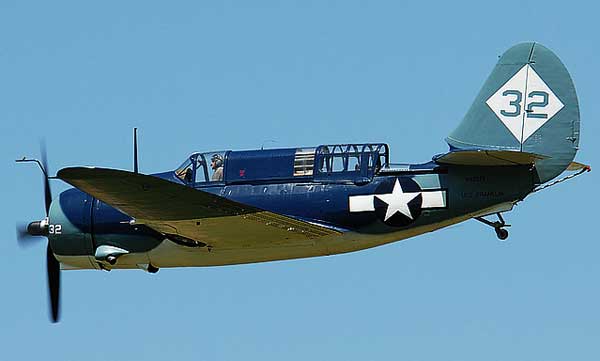
The dominating physical characteristic of the SB2C- 1 was the inordinate size of the wing and tail surfaces by comparison with that of the fuselage. The two-spar stressed-skin aluminum-alloy wing was built in four sections, two of these being bolted to the fuselage and comprising the center section, and the outer panels folding manually upwards immediately outboard of the main undercarriage attachment points. The ailerons were dynamically and statically balanced. and the remainder of the trailing edge of the wing was occupied by split plain flaps which opened both upward and downward to serve as dive brakes, hydraulic locks for the upper portions permitting the lower flaps to operate in orthodox fashion for landing. These flaps set up tremendous tail buffet when serving as dive brakes and were, in fact, to be perforated from the SB2C-4 (and equivalent CCF and Fairchild) model to alleviate this highly disconcerting phenomenon. Slats mechanically linked with undercarriage actuation extended from the Outer third of the wing leading edge to aid lateral control at low speeds. A 105 US gal self sealing fuel tank was housed between the spars of the center section on each side, and whereas the first production aircraft carried a pair of 0.50-in (12,7-mm) machine guns with 1,600 rounds in each center section half, these were replaced in subsequent aircraft (SB2C-IC) by a 20-mm cannon on each side with a combined total of 800 rounds, this installation reducing gross weight by 228 lb.
The oval-section fuselage was an aluminum-alloy semimonocoque structure with a flush-riveted smooth Alelad skin. The pilot, who was provided with an armour glass windscreen and back armour, was seated immediately forward of the fuselage fuel tank of 110 US gal capacity which could be supplemented by a jettisonable 130 US gal weapons bay tank, he weapons bay was equipped with hydraulically-operated doors and normally accommodated a single 1,000-lb bomb or two 500-lb bombs, although it could house a 1,600-lb bomb or two 1,000-lb bombs, and if the weapons bay doors were removed and a supporting truss installed a Mk 13-2 torpedo could be carried. The gunner was provided with a single 0.50-in (12.7-mm) gun in early production aircraft, but this was replaced at an early stage by a pair of 0.3-in (7.62-mm) guns on an armored mount with 2,000 rounds. The tail had aluminum-alloy frames and the fixed surfaces were covered by flush-riveted Alclad skin, the movable surfaces being fabric covered.
The massive increase in weight by comparison with the prototype had exacted a commensurate toll on performance and it was quickly ascertained that maximum and cruise speeds of the production SB2C-1 Helldiver were scantly better than those of the SBD Dauntless that it was intended to succeed, the older aeroplane being appreciably more maneuverable and suffering none of the adverse stall characteristics and marginal low-speed handling of the new Curtiss dive bomber. The Helldiver had been designed to haul a very much larger bomb load over a very much greater range at appreciably higher speed than the Dauntless, but much had happened between drawing board and production aeroplane, andalthoughtheSB2C-t was finally committed to combat VB-17 which flew its first operational sortie from the USS Bunker Hill in the second strike against Rabaul on 11 November 1943, it was tacitly admitted that the Helldiver was still far from operationally effective. As one VB- 17 pilot is recorded as having commented at the time, "The SB Deuce has more bugs than an oriental flophouse!'
As the numbers of Helldiver's aboard US Navy carriers increased,
serviceability improved - although never to be considered good
- and the growing familiarity of US Navy pilots with the unpleasant
nature of the Curtiss dive bomber reduced accident attrition to
acceptable levels, but there was little to endear the Helldiver
to its crews, air or ground, to 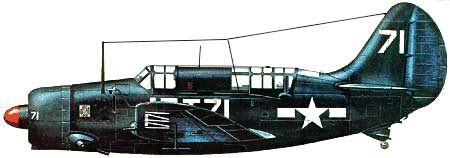 whom it had become the "Beast".
whom it had become the "Beast".
However, the production lines were continuing to churn out this least attractive of all US Navy production combat aeroplanes and the output from Columbus was being supplemented by Canadian production Canadian Car & Foundry having flown its first Helldiver (as the SBW-1) on 29 July 1943, with Fairchild Aircraft having followed suit (as the SBF-1) on 28 August of the same year. The 26 Helldiver's assigned to the FAA under Lease-Lend arrangements were, in fact, CCF-built SBW-lBs) the suffix letter indicating Britain) and equivalent to the Curtiss-built SB2C-1C.
One of the FAA's SBW-1B Helldiver's (JW115) duly arrived at Farnborough, as previously recounted, late in October 1944, the intention being to assess its dive-bombing qualities in particular and its handling characteristics in general in comparison with the Douglas SBD-5 Dauntless and the Vultee Vengeance IV, and as deck landing assessment was also involved, I was inevitably assigned the task. The Helldiver was an aggressively stolid aeroplane and once one had become accustomed to the immensity If its wing and tail surfaces by comparison with its stubby, porcine fuselage, it was not unpleasing to the eye.
The big Wright R-2600-8 Cyclone 14, which, by this time, had overcome most of the problems that had plagued its early mating with the Helldiver airframe, growled healthily, its tone reminiscent of that of the smaller single-row Cyclone that I had known so well in the Wildcat. While warming up, I had time to look around the cockpit, the layout of which could best be described, in Irish parlance, as organized chaos! There was no evidence of constructive planning, yet one could not complain that anything was not to hand - except for the rudder trimmer which was a somewhat vital exception. It was simply a case of knowing where to look. The cockpit was, in typical American fashion, both roomy and comfortable, but I found that the rudder pedals and control column were at full reach.
The view from the cockpit on the approach was fairly acceptable until hold-off and then the rise of the nose blanked off most of the view dead ahead and slightly to each side. On cutting the throttle there was an acute nose-down change of trim, meaning that a wheely landing was inevitable, but the delightfully soft undercarriage absorbed all bounce. There was no swing on the landing run, presumably due to the combination of stabilizing effect of the wide undercarriage and the tail wheel lock. The baulked landing case revealed that the trim change on application of engine power was most emphatically excessive. I found that I could just hold the nose-up change of trim with as much forward pressure on the column as I could apply at a mere 30 in Hg manifold pressure. Quite frankly, with the terrible aileron control at approach speed and the excessive longitudinal trim change with engine power, the Helldiver would never have been acceptable for deck landing by British standards, and, indeed, was never flown onto a British carrier by an FAA pilot. One could only sympathies with the US Navy pilots flying this unpleasant aircraft from carriers in the Pacific, wonder that their accident attrition was tolerable and understand their choice of nickname for the Helldiver For my money, all the effort that Curtis Wright and the US Navy had put into an attempt to turn what was so obviously a wrong one from birth into at least a reasonably acceptable shipboard aircraft had been wasted. The Helldiver was a beast!
Further minor changes, such as the perforation of the wing flaps to inhibit tail buffeting and the provision of racks under the outer wings for 45 in rockets, resulted in the SB2C-4 as Curtiss-Wright and the US Navy continued to endeavor to extract the best possible from a bad job. No fewer than 2,045 SB2C-4s were to roll off the lines, including a number equipped with radar as SB2C-4Es (plus 270 SBW-4Es and 100 SBF-4Es). Meanwhile, the Helldiver was playing an increasingly important r6le in the Pacific War, although, in truth, the really critical phases of the conflict had passed, having been fought out by the Dauntless. However, WW II was approaching its end and with it the production career of the Helldiver. Only one other production model was to appear, the SB2C-5 with 35 US gal more fixed internal fuel which began to leave the the Columbus line in February 1945, a total of 970 being produced (plus 86 of the equivalent CCF-built SBW-5).
If the 900 examples of the land-based equivalent of the SB2C-1 built for the US Army Air Force as A-25As under the Army-Navy standardization program with naval equipment and wing-folding mechanism deleted- although, in the event, 410 of these were reassigned to the Marine Corps as SB2C-lAs - are added to the shipboard models built for the US Navy, the grand total of Helldiver's completed is some 7,140 aircraft. This quantity is far greater than that of any other dive bomber built by any nation, yet, ironically, in the role for which it was created, the Helldiver was one of the least efficacious aircraft. Its production life had been plagued by innumerable problems, many of which were inherent in its basic design and incapable of solution. Yet, despite manifestly inauspicious characteristics, production was persisted with. There can be no doubt that the Helldiver was committed to quantity manufacture before the true nature of the beast had been ascertained and once the machinery for mass production had begun to turn, none was willing to admit the mistake and bring it to a halt..
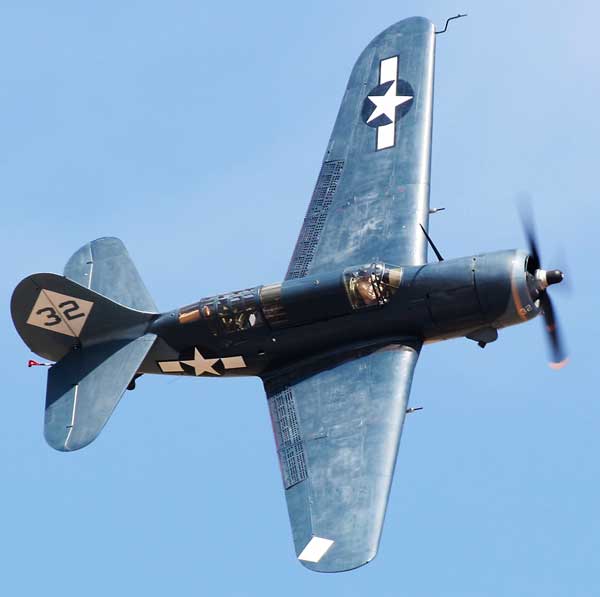
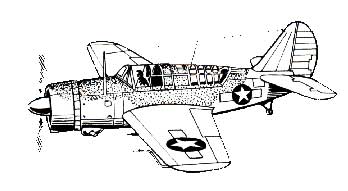
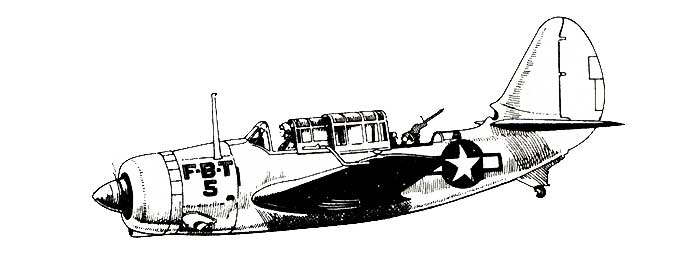
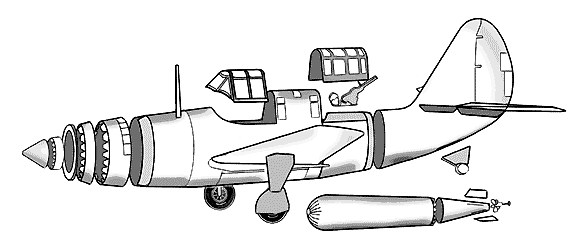
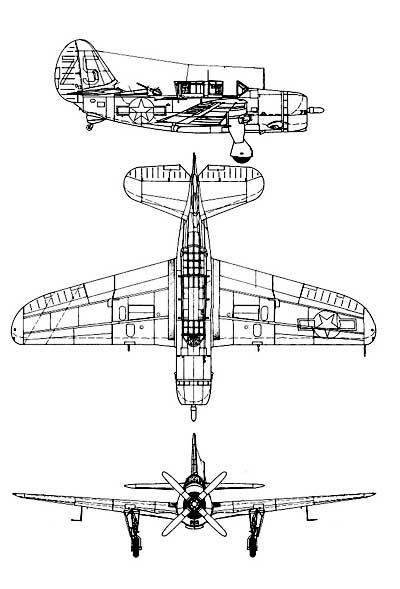 |
Crew: Two, pilot and radio operator/gunner Length: 36 ft 9 in Wingspan: 49 ft 9 in Height: 14 ft 9 in Wing area: 422 ft² Empty weight: 10,114 lb Loaded weight: 13,674 lb Max takeoff weight: 16,800 lb Powerplant: 1× Wright R-2600 Cyclone radial engine, 1,900 hp Performance Maximum speed: 294 mph Range: 1,200 miles Service ceiling: 25,000 ft Rate of climb: 1,750 ft/min Armament 2 × 20 mm (.79 in) cannon in the wings 2 × 0.30 in (7.62 mm) M1919 Browning machine guns in the rear cockpit Internal bay: 2,000 lb of bombs or 1 × Mark 13-2 torpedo Underwing hardpoints: 500 lb of bombs each |
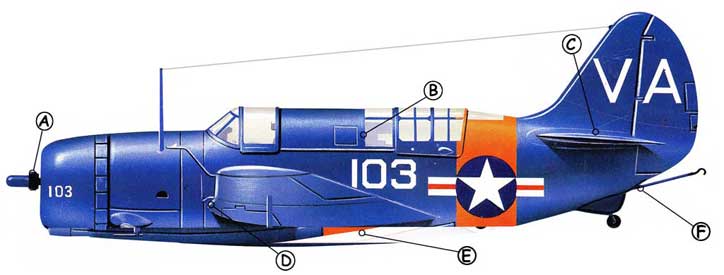 |
||
| A: One early source of trouble for the Helldiver was the Wright Cyclone engine and its Curtiss Electric four-bladed propeller. Many of the propellers, like this one, had the spinner removed in service. | B: The gunner of the Helldiver was protected by a large sheet of armour. Between him and the pilot was the radio bay, the life raft, the autopilot controls and a large fuel tank. | C: Tail buffeting was a constant problem for the Curtiss SB2C Helldiver, and despite a redesign it never entirely disappeared. |
| D: Upper surface divebrakes were fitted to the wing of the SB2C, and the the trailing-edge flaps were split. The leading edge slat opened simultaneously with undercarriage operation. | E: Unlike earlier dive bombers, the SB2C had a large internal bomb-bay with displacement gear for the bombs and hydraulic doors over the bay. The wingroot contained additional fuel tanks. | F: The arrester hook on the Curtiss SB2C was connected to a large hydraulic damper to reduce the impact of catching the deck wire. |
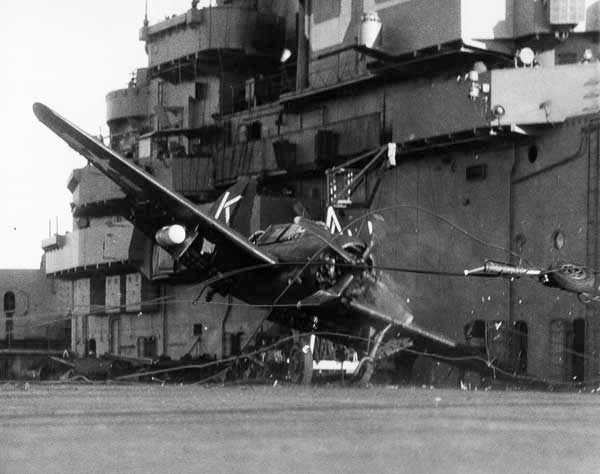 |
A U.S. Navy Curtiss SB2C-5 Helldiver of attack squadron VA-34 Black Panthers, Carrier Air Group 3 (CVG-3), pictured in the midst of a spectacular barrier crash on the flight deck of the aircraft carrier USS Kearsarge (CV-33) during operations in the Atlantic Ocean, in 1948. |


